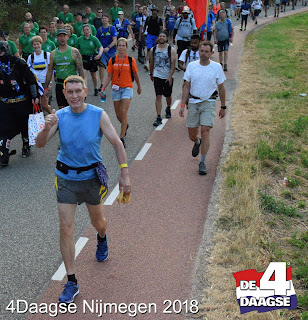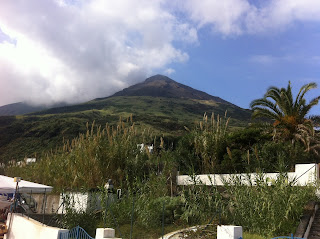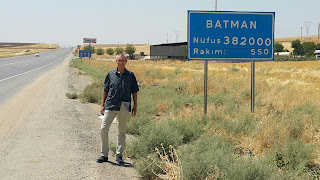Ton van Zutphen aiming for his 10th medal during the
Walk of the World in Nijmegen, the Netherlands, and preparing in Goch, Germany (where his grandfather, father’s side, lived
and worked (1891 to June 1900)
Written at home in Leende, NL, last week July 2018 (tonvanzutphen@gmail.com)
It has been nearly two years since I wrote a blog;
meanwhile the stats inform me that nearly 30.000 readers looked at any of the
previous 21 blogs that I wrote since 2012. The first one took me to the Via
Francigena in May 2012 when I lived in Rome. This is the official St. Francis
walking trail to Rome. A disproportionate number of my possibly 'crazy' blogs are readers from Russia and
the Ukraine…where I hardly know anybody; and I cannot offer the reader an explanation for this.
Admittedly, blogging is a bit of an exercise to ‘put oneself up there on social media’. Nevertheless, I also write because some of
my friends, old working buddies, and family, remain genuinely interested in my travels and activities.
PART ONE
Last year I typed out and added some information on
the document that my uncle Martin van Zutphen wrote before he died on a cruise ship
close to Istanbul…heart attack. It was all a shock to us when this happened on 3rd October in 1989.
I will post this exceptional document later this year as some pics
need to be added still.
My wife Biya calls me Anton and this is exactly the
name of my grandfather Anton van Zutphen (or Antoon in Dutch) who was born in
Veghel in 1872 and died in Eindhoven just at the end of the second WorldWar in May
1945.
Anton married a German beauty Anna Maria Hoffmann in 1897. She was apparently born out of wedlock and in the beginning to shy to respond to the advances made by Anton who according to some stories and pictures was full of confidence and cash, had a good job as a cooper (barrel-maker) and was smoking big cigars since he was 16; and equally fashionably dressed during the German Empire period around the 1900’s.
Anton married a German beauty Anna Maria Hoffmann in 1897. She was apparently born out of wedlock and in the beginning to shy to respond to the advances made by Anton who according to some stories and pictures was full of confidence and cash, had a good job as a cooper (barrel-maker) and was smoking big cigars since he was 16; and equally fashionably dressed during the German Empire period around the 1900’s.
Coincidentally my youngest daughter Kesso Gabrielle next year has agreed to marry a Swiss young man named Thomas Kueffer….which means cooper in German.
Anna Maria was born in Asperden 3 kms from Goch in 1874 and had lived with her mother in Pfalzdorf also just 4 kms from Goch. She and Anton raised 5 children of which my father Franz was the youngest, born in Neuss am Rhein in 1906. So I decided to walk around the small town of Goch…along the river Niers and visit the streets and villages where my grandfather must have walked and lived…Kirchstrasse, Gartenstrasse where he lived on nr. 54, Feldstrasse where their first daughter Dina was born, Markt, Steintor. All streets are there but as Goch was bombed out in 1943/44 for 80%, most of the buildings are new and only a few rebuilt in the old style. Goch in 1890 had about 5.000 inhabitants while in 2017 we count 33.000 people.
More and more Dutch people buy houses in this border area here because Germany is arguably the cheapest country in Europe if you look at it from a price/quality perspective. I had a draught Bitburg beer at 1,60 euros at the ‘Heidetreff’ bar in the Uedemer strasse. The Feldstrasse / Fieldstreet still has a charming 400 metres ending up in what must have been the outskirts of the hilly Pfalzdorf village where my grandmother had lived with her mother. Anton must have walked this stretch many many times puffing his cigar while holding hands of the lady he was going to marry…happily ever after. The photograph below was taken in Veghel at the barrel making factory of the firm van den Tillaart. My grandfather started working as an apprentice when he was 12 years young. On this pic. he is standing fully left with a cigar in his hand, in costume and 16 years young. 'Den Heer'...or Sir Anton.
The below picture taken in Neuss am Rhein (Germany) probably around 1908 presents Anton's nuclear family / clockwise Anna (mother of Jos, Ria, Toon and Henny..Anna was apparently accidentally killed by an English soldier in 1945 in Eindhoven). Then my grandfather Anton, Martin, the eldest son, Dina, the eldest daughter, Franz, my father, Anna Marie, my grandmother born in Asperden, Germany, and finally to the full right Frits. Toon lives in New Zealand with his lovely wife Josiena..also from Eindhoven originally, and Henny who lives close to Utrecht in the NL. Please may you note the beauty of my grandmother!!
In Goch I stayed in the traditional Hotel ‘Zur Friedenseiche’ (At the Oak of Peace)…very good and top clean, managed by what we Dutch would call a typical German: straightforward, punctual with breakfast, clear on how to use the front door and parking lot. I enjoyed it thoroughly and can recommend it without any reservation. Centre of town, very nice room at 55 euros a night with excellent breakfast. I simply walked in without any reservation…plenty of rooms available. The owner Theodor Welmsen kept all the furniture from the mid sixties and it is as if you are stepping back half a century in time. Unfortunately he would not want to sell me one of his 3 'Stiefels'... a typical traditional drinking device.
And I walked
along the old German railway line …the train from Boxtel in the NL to Wesel in
Germany, with which my grandfather arrived in Goch in 1891 when he was only 19
years young. The fact that I also
stepped out of my comfort zone in the Netherlands, and worked in many places
around the world, married outside the NL, and also carry his name….makes me
feel somehow associated with him in a particular way.
For those interesting to spend 2 days exploring the
Goch area I can recommend a full day
walk along the meandering river Niers, and visit the local museum and have
plenty of good beers in the market place (Koenig, Veltins, Bitburg). I walked
through all the places mentioned above and
in perfect weather. Unfortunately I found out later that training for
the Walk of the World (every day 40 kms) requires more than just a 100 kms
training over 3 days
PART TWO
So every year I do some walking to prepare myself for
the 4 Days marches of Nijmegen…and with my advancing age…I realise I need to do
more preparation. It is now the third time that the shin splint effect returns
when I stretch my muscles too heavy. This time it started on the second day and
I felt I had to restrain/limit the speed. Anyway a bit proud of myself…on day 1
I started at 5.20am and clocked in at 10.30 am sharp….first arrival of the
group that walks 40 kms. At least 7 or 8 walkers that power walk or racewalk 50
kms each day, were ahead of me. The weather had been wonderful and sunny with a
cool breeze when walking on the Waal-dyke along Oosterhout. Day2 I arrived at
12.30, day3 with Ruud from Venlo, and a Swedish army officer at 11.am.
And day4 with
some pain at 13.45 hours finally. An interesting artefact is the pontoon bridge
that the Dutch infantry puts every year together to enable the crossing of the
river Maas at Cuyk (Ceuclum was the name during the Roman invasion where a fort
was built as part of the road Nijmegen to Maastricht plus also a wooden pontoon
bridge / and remember: the Maas was then a wildly meandering river fed mainly by
the rains in Northern France and Belgium). Most walkers like day4 because of
the throngs of people that are encouraging all 40.000-plus walkers during the
final 7 kms. But I find the wide tarred road a hot walking blacktop, noise and
music increase the perception of the heat, and I had run out of red Korean ginseng
that always gives a boost for at least a couple of kilometers.
This year’s music I heard most was 1. Una paloma
blanca from the George Baker Selection (1975), 2. Take me home country roads
from John Denver (1971) and 3. Atemlos durch die Nacht from Helene Fischer
(2014). I do recall meeting John Denver personally in Ouagadougou in 1985 when
he visited the SAVE US programme. A very nice country boy indeed he was.
Anyway I made it for the 10th time,
received my gold-plated medal and joined the select club of those with 10
marches behind their belt. To serve this select group there are specially
equipped resting places along the route (obviously the majority being over 60
years of age).
Nothing really exciting happened during this 10th
Walk of the World. Definitely more and more walkers use earplugs and walk in their
own bubble…or are on the phone. All of this is not conducive to the friendly
atmosphere that was different in the past.
One of the reasons I continue to walk every year is
because of my student friend Cees Boonman who died 12th July 2012 on
a Sunday preceding the 4DaysWalk. I used to stay with him and his wife Antonet
in their homes in Nijmegen. It is good to think of him and pray that he may see
that his old study friends do remember him well, offer him a toast, and gather;
as we do every Sunday preceding the annual march in the Kronenburger Park.
Antonet’s family joins then and friends of Cees, plus usually Jan Konings, his
wife Karin and myself.
CEES....jij bent niet meer waar je was. Maar overal waar wij zijn.
CEES,... you are not anymore where you were. But you are everywhere where we are.
Also part of the ritual now is that the student’s friends (the Brommers) meet on day3 as of 3pm at café-bar ‘De Kroon’, Daalseweg 361, some 750 meters from the finish. A wonderful time it was again this year!! Some 47.000 walkers registered and a little over 40.000 finished this year’s biggest walking event in the world.
From left to right: Wilma (64), Wim (66), Gerard looking swell at 71, Antonet (58), and Ton (66).
CEES....jij bent niet meer waar je was. Maar overal waar wij zijn.
CEES,... you are not anymore where you were. But you are everywhere where we are.
Also part of the ritual now is that the student’s friends (the Brommers) meet on day3 as of 3pm at café-bar ‘De Kroon’, Daalseweg 361, some 750 meters from the finish. A wonderful time it was again this year!! Some 47.000 walkers registered and a little over 40.000 finished this year’s biggest walking event in the world.
From left to right: Wilma (64), Wim (66), Gerard looking swell at 71, Antonet (58), and Ton (66).
The city of Nijmegen turns every 3rd week
in July into the busiest place in the NL. It swells from 175.000 people to
receiving more than 1 million visitors over a 6 day period. Festivities with
live music, expositions, street-theatre, even a special white sandy beach along
the Waal is created, bars on the streets…about 30 extra locations. I ran into a
trucker who collected the 1.000 liter cisterns in which the beer is now being
distributed. He collected the Heineken /Amstel cisterns and his group refilled
on a daily basis 75 of these huge metal shiny cisterns. Assuming that
Heineken/Amstel group has a max. of 30% of the beer market in Nijmegen….. we
are looking at a beer consumption of Nijmegen city alone of perhaps 1.5 million
liters of beer over roughly 7 days/nights. !!! I was told only at the Black
Cross event in the NL in ‘the Achterhoek’ or around Assen this year, beer consumption of particularly the Grolsch
brand is bigger per capita.
Next year again…yes yes, hopefully with my wife Biya. And
then every day 30kms.




















